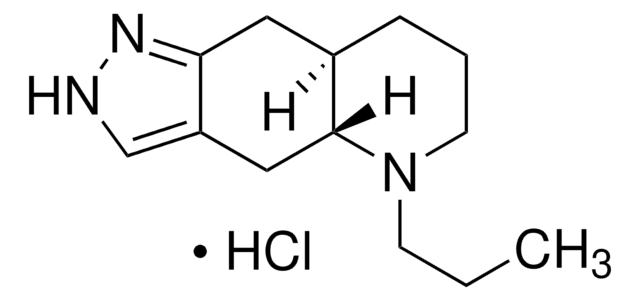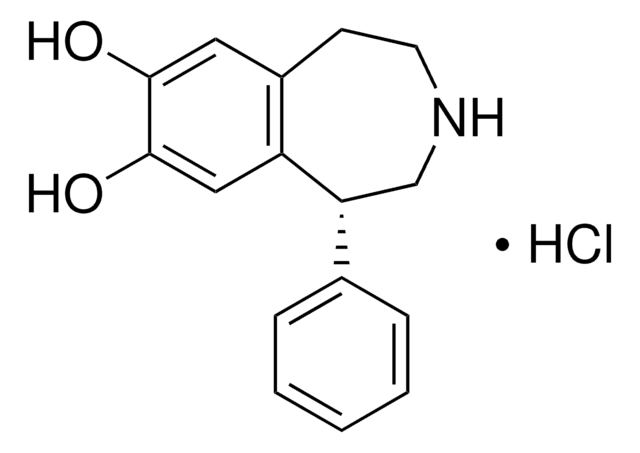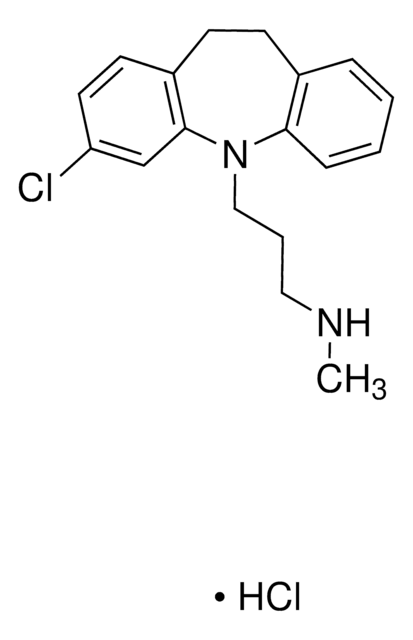推荐产品
品質等級
化驗
≥98% (HPLC)
形狀
crystalline
儲存條件
desiccated
protect from light
顏色
white
溶解度
H2O: >5 mg/mL
aqueous base: soluble (unstable)
SMILES 字串
Cl.Oc1cc2CCNCC(c3ccccc3)c2cc1O
InChI
1S/C16H17NO2.ClH/c18-15-8-12-6-7-17-10-14(13(12)9-16(15)19)11-4-2-1-3-5-11;/h1-5,8-9,14,17-19H,6-7,10H2;1H
InChI 密鑰
YEWHJCLOUYPAOH-UHFFFAOYSA-N
基因資訊
human ... DRD1(1812)
正在寻找类似产品? 访问 产品对比指南
應用
(±)-SKF-38393 hydrochloride has been used as a selective D1 receptor agonist as a part of dopaminergic treatment. It has also been used to study its effect on prolactin in male baboons.
生化/生理作用
(±)-SKF-38393 is a D1 dopamine receptor agonist. It is known to promote the production of glutamate in the hippocampus.
注意
This material is hygroscopic. Air-sensitive. Light-sensitive.
訊號詞
Warning
危險聲明
危險分類
Eye Irrit. 2 - Skin Irrit. 2 - STOT SE 3
標靶器官
Respiratory system
儲存類別代碼
11 - Combustible Solids
水污染物質分類(WGK)
WGK 3
閃點(°F)
Not applicable
閃點(°C)
Not applicable
個人防護裝備
dust mask type N95 (US), Eyeshields, Gloves
其他客户在看
Stimulation of dopamine D1 receptor improves learning capacity in cooperating cleaner fish
Messias JPM, et al.
Proc. Royal Soc. Lond. B., 283(1823), 20152272-20152272 (2016)
Prolactin and fMRI response to SKF38393 in the baboon
Miller B, et al.
PeerJ, 1(5), e195-e195 (2013)
Dopamine disruption increases cleanerfish cooperative investment in novel client partners
Soares MC, et al.
Royal Society open science, 4(5), 160609-160609 (2017)
The D1 dopamine receptor agonist SKF-38393 stimulates the release of glutamate in the hippocampus
Bouron A and Reuter H
Neuroscience, 94(4), 1063-1070 (1999)
David Kabelik et al.
Neuropharmacology, 58(1), 117-125 (2009-06-23)
Recent experiments demonstrate that aggressive competition for potential mates involves different neural mechanisms than does territorial, resident-intruder aggression. However, despite the obvious importance of mate competition aggression, we know little about its regulation. Immediate early gene experiments show that in
我们的科学家团队拥有各种研究领域经验,包括生命科学、材料科学、化学合成、色谱、分析及许多其他领域.
联系技术服务部门









